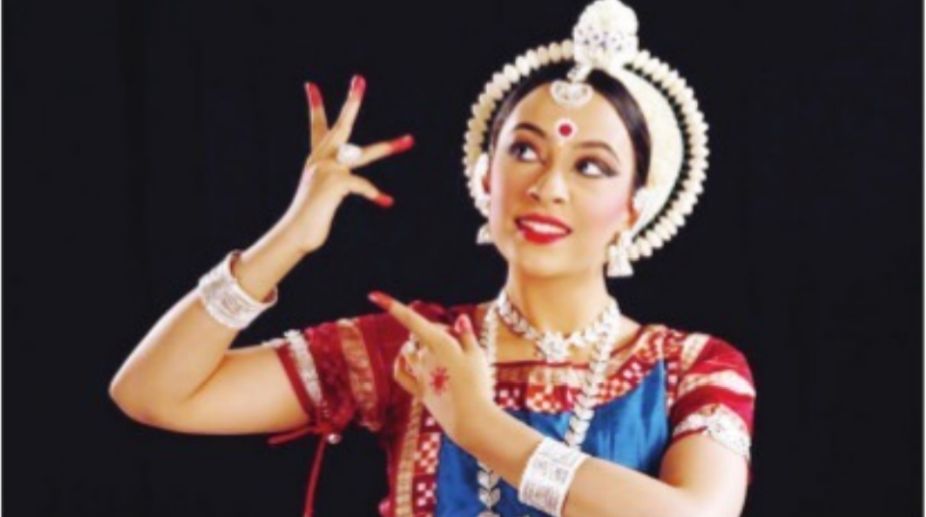Remembering Rukmini Devi
Thanks to Kathak exponent Ashimbandhu Bhattacharya and his team consisting of Avik Chaki and Subroto Pandit, rasikas got a glimpse of their excellent Kathak rendition.

lyrical grace (PHOTO: SNS)
If there is one disciple of late Guru Kelucharan Mohapatra, who has kept his legacy, it is Madhavi Mudgal. She has imbibed some of the finest qualities of the worldrenowned Guru; his sense of aesthetics and Lasya, the lyrical grace of movements, the sense of rhythm and perfection in every aspect, those are the hallmarks of his style. Madhavi has assimilated the essence of the inimitable Guru…,” deliberated Ambassador Lalit Mansingh at the India International Centre (IIC) auditorium, launching a set of two DVDs presenting some of the remarkable choreographies of Madhavi Mudgal, released by the Gandharva Maha Vidyalaya (GMV).
The distinguished dancer-choreographer, Madhavi Mudgal, was herself present, to introduce the selected solo and group choreographies being screened for the invited audience this evening. It was a delight to listen to the self-effacing Madhavi, who normally speaks only through her dance, the stories, anecdotes and references about the particular pieces while they were being choreographed. Rang Stuti, for instance, was written by Bharata Muni as an invocation to the RangDevata, the stage. So to give its music a sense of belonging to that era, the genius composer Pt Madhup Mudgal chose to base the Sanskrit shloka (couplet), on Swayambhoo(self-resonating) Swaras, instead of a present day Raga.
Introducing Pallavan, Madhavi explained that it was a Nritta-oriented piece depicting how one Bhangima goes to another, making a Karanaand how so many Karanastogether make Angahar and then how the Laya, or rhythm, comes to the introduction of Tala. Then there was a group choreography named Teevra Madhyam, where this particular Swara (note) was the focal point. The music moved through several ragas like Hindol, Marwa, Basant and Kalyan, coming back to the pivotal note Teevra-madhyam and we were amazed to see how the choreography translates it into a visual poetry.
Advertisement
The choreographic piece, based on Kalidasa’s Kumar-Sambhav, the solo by Madhavi herself on Jayadeva’s Ashtapadi from Geeta-Govinda, the choreography based on the folklore of Odisha, the Ganga-Stavanby Padmakar to Vadya-Vaividhya,’ depicting different percussion instruments of Odisha, there was no end to the Vaividhya, or variety of Madhavi’s captivating choreographies. The creativity of the imaginative choreographer, melodiously composed music, the impeccable synchronisation of the chiselled dancers and the poetic photography made it a visual treat. Kudos to the choreographer, the music composers, the well-trained dancers, the exquisite photographer and, of course, the GMV for bringing out such precious DVDs.
Manch-Pravesh of Kamya Goenka
Padma Shree awardee Guru Madhavi Mudgal was seen again as the encouraging chief guest for the Odissi Manch-Pravesh of young Kamya Goenka, at the IIC auditorium this past week. The 17-year-old Kamya, a student of Modern School, started learning Odissi a decade back at the tender age of seven, under Guru Dilip Kumar Mohapatra. She is at present being trained under Guru Panchanan Bhuyan, who in turn is a reputed disciple of the late Guru Kelucharan Mohapatra. The multi-talented Kamya is also a painter and a squash player.
Endowed with a pleasing stage presence, an erect stance and agility, Kamya opened her first ever solo Odissi performance with Mangalacharan, composed in raga Pahadi and Mohanam or Hindustani Bhupali set to Triput and Ekatala, an invocation to Lord Jagannath, Saraswati, the goddess of knowledge and learning, and Lord Ganesha, remover of all obstacles, the Bhumi Pranam to the Earth asking forgiveness for stomping on her and the Trikhandi Pranamto the audience for their blessings.
This was followed by the Battu Nritya for Batuk Bhairav, to please the fierce Shiva, sculpting the poses of Veena, Mardal, Kartal and Venu (Flute) players. Kamya’s ability to knit in the Tisra and Chatusra combinations of footwork showed her feel for accurate timing and rhythm. The Bilahari Pallavi was again a rhythm-oriented Nritta or pure dance, depicting the raga through eye movements, hand gestures, lyrical body movements and intricate footwork.
The Odia song "Kede Chhanda…" by Banmali Das, presented as an Abhinaya piece, stringing together engaging episodes of Krishnaleela, saw Kamya engaged in the Bakaruravadha, Shakatasura-Vadha and Kaliya Daman Leelas, followed by the Vishwaroop Darshan in the open mouth of child Krishna. "Shrita Kamala…" Ashtapadi from Jayadeva’s Geeta-Govinda was Kamya’s other Abhinaya piece before she concluded her Manch-Pravesh with the Moksha in Bhairavi.
Kamya has got perfect sense of rhythm. Abhinaya, which is bound to evolve more with age and experience, is sensitive to music and poetry.The musical interlude, with the Ashtapadi "Mamiyam chalita vilokya…" melodiously sung by GuruVijay Kumar Jena in raga Bageshree, created positive vibes while the young dancer changed costumes for Abhinaya.
Advertisement